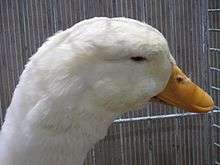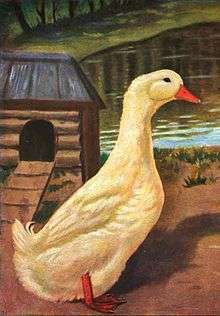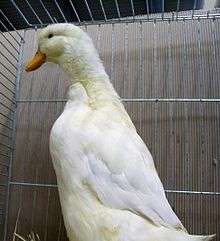German Pekin
The German Pekin (German: Deutsche Pekingente) is a European breed of domestic duck. It is commonly called simply Pekin or White Pekin.[4][5] It is a different breed from the American Pekin, which is also commonly known by the same names. It was bred in Europe from birds originating in China and Japan and is distributed in many European countries.[2][4]
 | |
| Conservation status | |
|---|---|
| Other names |
|
| Country of origin | China |
| Distribution | Europe |
| Use | meat |
| Traits | |
| Weight |
|
| Egg colour | white or tinted |
| Classification | |
| EE | yes[2] |
| PCGB | heavy[3] |
| |


History
The mallard was probably domesticated in China before 1000 AD.[6]:92 Force-feeding of ducks is documented from the tenth century, under the Five Dynasties.[7]:593 Chinese people were sophisticated breeders of ducks.[6]:92 Among several breeds they created was one named shi-chin-ya-tze, or roughly "ten-pound duck".[8]
In 1872 some birds of this type were imported to the United Kingdom by Walter Steward;[8] others were taken to the United States by James E. Palmer, where they gave rise to the American Pekin breed.[6]:92 Some soon reached Germany from the UK, possibly via France.[9][10]
In Germany the Chinese ducks were cross-bred with upright white ducks brought from Japan by Dutch ships, resulting in birds with a steep body angle; those taken to the United States were crossed with Aylesbury birds, which led to birds with a more horizontal stance.[8] In Britain as in Germany, breeders in the early twentieth century tended to select for an upright body position. The modern British breed derives mostly from birds imported from Germany from about 1970.[10]
The German Pekin is listed as "seriously endangered" in the Rote Liste of the Gesellschaft zur Erhaltung alter und gefährdeter Haustierrassen, a German national association for the conservation of historic and endangered domestic animal breeds.[11] In the United Kingdom it is considered "vulnerable".[12]
Characteristics
The Pekin is heavily feathered; the plumage is creamy white with a yellowish tinge.[8][10] The beak is short and orange-coloured.[10] The body is broad and heavy, and is held almost vertical. In the United Kingdom, drakes weigh approximately 4.1 kg and ducks about 3.6 kg,[13]:438 while in Germany drakes weigh approximately 3.5 kg and ducks about 3 kg.[14]
Use
The Pekin was intended to be a table bird, reared for its meat. In Germany it has not been kept for agricultural production since about the time of the Second World War, and is a show bird.[9] Ducks lay about 80 eggs per year; the eggs weigh approximately 80 g.[14]
References
- Barbara Rischkowsky, D. Pilling (eds.) (2007). List of breeds documented in the Global Databank for Animal Genetic Resources, annex to The State of the World's Animal Genetic Resources for Food and Agriculture. Rome: Food and Agriculture Organization of the United Nations. ISBN 9789251057629. Accessed February 2017.
- Liste des races et variétés homologuée dans les pays EE (28.04.2013). Entente Européenne d’Aviculture et de Cuniculture. Archived 16 June 2013.
- Breed Classification. Poultry Club of Great Britain. Archived 12 June 2018.
- Transboundary breed: Pekin. Domestic Animal Diversity Information System of the Food and Agriculture Organization of the United Nations. Accessed February 2017.
- Transboundary breed: White Pekin. Domestic Animal Diversity Information System of the Food and Agriculture Organization of the United Nations. Accessed February 2017.
- Dave Holderread (2011). Storey's Guide to Raising Ducks, second edition. North Adams, Massachusetts: Storey Publishing. ISBN 9781603427456.
- Alan Davidson (1999). The Oxford Companion to Food. Oxford: Oxford University Press. ISBN 9780192115799.
- Kenneth Broekman (December 2009). The German Pekin Duck. Aviculture Europe. 5 (6), article 12. Accessed February 2017.
- Deutsche Pekingente (in German). Vielfältige Initiative zur Erhaltung gefährdeter Haustierrassen. Accessed February 2017.
- Chris Ashton, Mike Ashton (2001). The Domestic Duck. Ramsbury, Marlborough: The Crowood Press. ISBN 9781847979704.
- Deutsche Pekingenten (in German). Gesellschaft zur Erhaltung alter und gefährdeter Haustierrassen. Accessed February 2017.
- Pekin/United Kingdom. Domestic Animal Diversity Information System of the Food and Agriculture Organization of the United Nations. Accessed February 2017.
- Victoria Roberts (2008). British poultry standards: complete specifications and judging points of all standardized breeds and varieties of poultry as compiled by the specialist breed clubs and recognised by the Poultry Club of Great Britain. Oxford: Blackwell. ISBN 9781405156424.
- Breed Details duck: Deutsche Pekingenten. Bundesanstalt für Landwirtschaft und Ernährung – TGRDEU. Accessed February 2017.
External links
